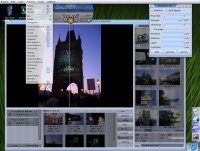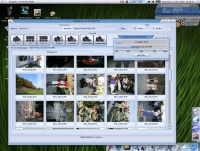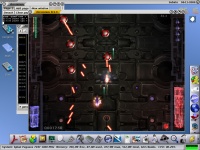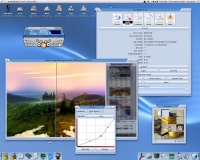Applications dédiées
From MorphOS Library
La taille réduite de l'OS et sa structure simple (en termes relatifs) impliquent, entre autres, que beaucoup de projets exigeant une équipe de programmeurs sur d'autres plateformes deviennent souvent des projets individuels modestes dans les environnements MorphOS/Amiga. Cela ralentit le développement, mais donne également une excellente efficacité, simplicité et compacité au code. Dans cette section, nous mentionnons quelques excellents outils pour MorphOS, alors que dans la prochaine section vous trouverez des descriptions pour les applications les plus importantes et les plus puissantes.
AmiNetRadio
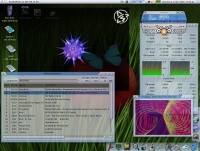
Une chose intéressante à mentionner est qu'en fait "ANR" est un code exécutable 68k codé pour AmigaOS 3.x. La transparence et l'efficacité de l'émulation dans MorphOS sont si bonnes que la plupart des lecteurs mentionnés ci-dessus sont compilés exclusivement pour MorphOS en code PowerPC, et peuvent être mixés sans que l'utilisateur ne s'en rende compte. Et il en est de même pour les greffons vidéos : "ANR" est compatible avec l'API d'AmiAMP (une vieille version Amiga de WinAMP), et il est donc possible de mélanger greffons 68k et PowerPC. Un fait encore plus intéressant est qu'il est possible d'utiliser des greffons compilés pour les vieux formats d'exécutables PPC (PowerUp et WarpUp, introduits il y a quelques années, à l'époque des cartes accélératrices PowerPC sur Amiga classique). Les personnes n'étant pas issu du monde Amiga ne doivent pas s'en inquiéter : tout se fait de manière transparente avec la totalité des exécutables que la communauté Amiga a introduit dans le passé, tant que ceux-ci ont été codés en respectant le sytème. "ANR" lui-même se sert de quelques extensions des API AmigaOS 3.x pour améliorer les possibilités de configurations des thèmes graphiques, il en résulte un programme MorphOS composé de code 68k.
ShowGirls
Comme son nom l'indique (et si cela ne vous évoque rien, cela signifie juste que vous n'êtes pas assez geek), c'est une visionneuse d'image. Alors que la visionneuse interne d'Ambient fournit les fonctions de base nécessaires, "ShowGirls" permet beaucoup plus : son interface est habituellement divisée en deux parties, d'un côté il y a les miniatures (avec support du format EXIF) et de l'autre côté l'image choisie est affichée. L'image peut être visualisée en plein écran, peut être zoomée (agrandissement ou retrécissement) et peut-être retravaillée. "ShowGirls" comporte en effet quelques outils de base afin de manipuler les images ce qui permet : d'ajuster les couleurs, de changer la résolution de l'image, d'effectuer des opérations de lissage et de netteté, de réduire le bruit, des effets de lueur et de flouttage, ainsi que la découpe, la rotation, le renversement tout comme des conversions par lots. Il est possible d'utiliser une vue 3D (avec le rendu 3D accéléré), mais c'est juste une option sympathique et secondaire.
The program was originally born as a tool for digital cameras, and in fact it can perform all the needed operations on files on a mass storage device. And in conjunction with a USB camera working as mass storage device you will rarely need anything else. If your camera supports the PTP standard, though, you might need to look elsewhere.
Starting from the 2.0 release of MorphOS, ShowGirls is provided with the OS itself as a contribution to be found in the Application directory, but additional updates are still available separately in the programmer's site.
PTPDigCam
This is a nice native and original software (not based on libraries ported from Linux) that enables to download and delete pictures, videos and audio files from Canon, Nikon, Kodak, Sony cameras supporting the PTP standard. The latest versions let the user choose the images from their Exif thumbnail as well, and the program is well written, with a nice and polished MUI interface. It is not the most complex program in the world, but it shows the spirit of the old Amiga community: most alternative OSs do not support the PTP standard and require the users to buy a card reader. As inexpensive as this add-on might be, it is always better to have a software supporting even this not so widely recognised standard. There is also an alternative, called SimpleCam and based on libPTP ported from the Linux environment, but with a MUI GUI. And for those who like to control remotely their digicam, there is also CanonToolBox, based on libPTP, too.With the release of MorphOS 2.0, the USB stack Poseidon directly supports the PTP standard. It is therefore possible to access the contents of any digicam internal memory just like it was a mass storage USB device. Obviously, since Ambient supports image thumbnails, it is possible to have a scaled preview of the pictures to be downloaded. It is still possible to use a third party program like PTPDigCam: the user just needs to unbind the device in the USB preferences, easily accessible from the System Preferences panel.
PowerSDL
This evocative name labels a software package, whose port allows to broaden, indirectly, the availability of software on MorphOS. Simple DirectMedia Layer (SDL) is a cross-platform multimedia library that provides an abstraction layer for graphics, sound, and input APIs over various platforms. SDL allows a developer to write computer games or multimedia applications that run on many operating systems, and makes a lot of ports possible. The MorphOS version has been greatly improved upon the original Amiga port, and it is now constituted by a number of shared libraries (which, incidentally, make possible to use them in closed source/non GPLed software) making full use of the MorphOS APIs.Frying Pan
While many AmigaOS applications can still be run on MorphOS, including the popular CD-writer software MakeCD, Commodore's demise preceded the introduction of DVDs. Thus Frying Pan, a CD / DVD burning and mastering software, is filling this gap meanwhile. The application is shareware and available natively for MorphOS.OS4Emu
This is an example of a software that broadens the working applications directly: it is a wrapper for the AmigaOS 4 APIs (which is very similar to the MorphOS one, given the common heritage) to the correspondent MorphOS functions. This means that by double clicking on the icon of an AmigaOS 4 executable (or typing its name in a CLI window) there is a good chance it will work. Notable examples include FPSE, the Sony PlayStation emulator, that ironically, thanks to Poseidon (the USB stack included in MorphOS), even supports USB joypads. (This is enabled by a simple feature in Poseidon, that associates keystrokes selected by the user to joypad buttons). Other working titles are SID4Amiga (a player for C64 music files), some scene demos, many shell commands and utilities, and much more. The compatibility is not total, but it is improving at every new release.
